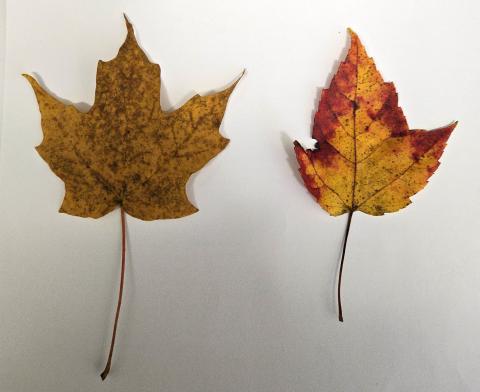Red or Sugar Maple? How do you tell the difference?
Red and sugar maples are part of what makes New England unique. In the spring, they provide the makings of maple syrup and in the fall, they provide our landscape with some of the brightest colors. Although they have a lot in common, there are many differences between these two species and there are several ways to tell them apart.
Red maples don’t necessarily have red leaves. The red in the tree’s name is from the color of the buds, which is particularly noticeable in late winter and early spring. Red maples have bright red buds, while sugar maple buds are tan.
Another differentiating characteristic to look at is the leaves. Red maples have three lobes (sometimes five if the small ones at the base are counted), finely serrated edges, and a V-shaped space (called a sinus) between the lobes. The sugar maple has five lobes, is smooth along the edges, and the space between the lobes is U-shaped. A good way to remember is that there is a letter “U” in sugar.
Leaves are only on the trees for half the year, so what characteristics can we use to identify maples in the other six months? Buds again are a useful indicator, and bark can also be used. Bark can be tricky, however. Red maple bark has several different appearances, depending on the age and vigor of the tree. Young and fast-growing red maple tends to have smooth gray bark, which can be confused with healthy beech bark. As the red maple ages or growth slows, the bark develops narrow vertical plates. As the tree gets older, these plates can take on a shaggy appearance, and they peel off easily. This can be a helpful way to distinguish red maple from sugar maple. The bark of a sugar maple, even if it looks a little shaggy, is usually very tight to the tree and doesn’t knock off easily like red maple bark does.
Sugar maple bark is not actually smooth like red maple when young. There is a small diamond-shaped pattern to it that can be hard to see, but the bark has a texture to it. It’s hard to describe and is best experienced by looking at and touching the bark. After a while one can start to get a feel for the difference in the bark between the two, but even seasoned foresters must look twice sometimes.
Red maple is an intermediate shade-tolerant tree, meaning that it doesn’t need full sun to germinate and become established, but it doesn’t do well in abundant shade either. Red maple also sprouts prolifically from the stump when cut, whether by people or beavers. Sugar maple is a shade tolerant tree so it can become established and develop under a closed canopy, though often it loses out to beech, which is a very shade-tolerant species. Sugar maple can sprout from the stump also, but not as reliably as red maple.
Another difference is that sugar maple is fussier when it comes to site conditions. Sugar maples need nutrient-rich, well-drained but not too dry and not too wet soils and do well on north- and east-facing slopes. Geographically they are found from the Lake States east to Maine, and south to Ohio and Pennsylvania. Red maples are tolerant of a wider range of soil and site conditions, and are found in many forest types, from Florida to Maine.
The wood is also different. Sugar maple, also known as hard maple or rock maple, is, as the names imply, dense and hard. It is one and a half to two times as hard as red maple and other hardwoods. For this reason, sugar maple lumber is commonly used in bowling lanes, basketball courts, flooring, butcher blocks, and other applications where hard, strong wood is needed.
Red maple is also called soft maple. Its wood is softer than sugar maple and is used in cabinetry, painted furniture, and more. It can be used in many applications where a medium density wood is needed. When prices for cherry lumber are high, red maple is sometimes used as a substitute because it can be stained to look like cherry.
Sugar maple trees are very good at walling off, or compartmentalizing, wounds, while red maples are not. A sugar maple that is damaged in some way, whether from a branch being broken off, or scarring from a tree or machinery scraping against it, can contain the damage and prevent rot from spreading through the interior of the tree. Conversely, red maple damaged in the same way will often have rot spread far from the wound site.
When it comes to making maple syrup, the sugar maple is favored. It is so named because its sap makes the best syrup due to its high sugar content. A basic rule of thumb is that a sugar maple has forty gallons of sap to one gallon of syrup, while the ratio in red maple is sixty to one. This varies in individual trees, but in general red maple has a lower sugar content, meaning that more sap needs to be boiled to make a gallon of syrup. Also, red maples bud earlier than sugar maple, so if one is tapping both in a sugarbush, taps will need to be pulled from red maple first. Syrup made from trees that are starting to bud out, known as “buddy” syrup, tastes terrible.
Though they are closely related, there are many differences between sugar maple and red maple. Both are important trees in the New Hampshire forest that provide color, food for wildlife and people, and wood products. Our forests would be very different and less interesting without them.
Have a question about your woods? Contact your Extension County Forester today!
Do you love learning about stuff like this? Subscribe to the NH Woods & Wildlife Newsletter.
A quarterly newsletter providing private woodlot owners in New Hampshire with woodlot management news, pest updates, resources, and more.

